The Insignificant Improvement of Corrosion and Corrosion Fatigue Behavior in Geothermal Environment Applying Boehmit Coatings on High Alloyed Steels
Abstract
1. Introduction
2. Materials and Methods
3. Results and Discussion
3.1. Influence of Alumina Coating on Static Corrosion Behavior of 1.4021
- Due to the surface tension the coating is thinner towards the edges of the coupons than in the center. Therefore, stress causes micro cracking at the edges with the capillary forces driving the saline aquifer brine underneath the coating wetting the base metal surface.
- The high porosity may also be cause for the instability of the coating. The brine may have contact to the base metal surface through pores that connect surface and environment. Early corrosion reactions cause the coating to detach then in lateral direction.
- The reliability of the coating may also be reason for failure, because the method of coating directly influences the continuity and thickness of the coating. Dip coating leads to an increasing thickness of the coating towards the bottom of the samples because gravity forces the sol to flow before its gel status. Due to the “flowing” of the sol a bulge precipitates that has higher micro stress than the remaining coating. Therefor micro cracking of the coating is initialized within this bulge. In general, the reliability of the coating is directly dependent on the homogeneity of the coating and its consistent thickness avoiding stress gradients along the surface.
3.2. Influence of Alumina Coating on the Corrosion Fatigue Behavior of 1.4542
4. Conclusions
Author Contributions
Funding
Data Availability Statement
Conflicts of Interest
References
- Thomas, D.C. Carbon Dioxide Capture for Storage in Deep Geologic Formations—Results from CO2 Capture Project, Volume 1: Capture and Separation of Carbon Dioxide from Combustion Sources. In CO2 Capture Project; Elsevier Ltd.: London, UK, 2005; ISBN 0080445748. [Google Scholar]
- Ruhl, A.S.; Goebel, A.; Kranzmann, A. Corrosion Behavior of Various Steels for Compression, Transport and Injection for Carbon Capture and Storage. Energy Procedia 2012, 23, 216–225. [Google Scholar] [CrossRef]
- Gale, J.; Davison, J. Transmission of CO2—Safety and economic considerations. Energy 2004, 29, 1319–1328. [Google Scholar] [CrossRef]
- Eldevik, F.; Graver, B.; Torbergsen, L.E.; Saugerud, O.T. Development of a Guideline for Safe, Reliable and Cost Efficient Transmission of CO2 in Pipelines. Energy Procedia 2009, 1, 1579–1585. [Google Scholar] [CrossRef]
- Russick, E.M.; Poulter, G.A.; Adkins, C.L.; Sorensen, N. Corrosive effects of supercritical carbon dioxide and cosolvents on metals. J. Supercrit. Fluids 1996, 9, 43–50. [Google Scholar] [CrossRef]
- Neši, S. Key issues related to modelling of internal corrosion of oil and gas pipelines—A review. Corros. Sci. 2007, 49, 4308–4338. [Google Scholar] [CrossRef]
- Förster, A.; Norden, B.; Zinck-Jørgensen, K.; Frykman, P.; Kulenkampff, J.; Spangenberg, E.; Erzinger, J.; Zimmer, M.; Kopp, J.; Borm, G.; et al. Baseline characterization of the CO2SINK geological storage site at Ketzin, Germany. Environ. Geosci. 2006, 13, 145–161. [Google Scholar] [CrossRef]
- Förster, A.; Schöner, R.; Förster, H.-J.; Norden, B.; Blaschke, A.-W.; Luckert, J.; Beutler, G.; Gaupp, R.; Rhede, D. Reservoir characterization of a CO2 storage aquifer: The Upper Triassic Stuttgart Formation in the Northeast German Basin. Mar. Pet. Geol. 2010, 27, 2156–2172. [Google Scholar] [CrossRef]
- Kissinger, A.; Noack, V.; Knopf, S.; Scheer, D.; Konrad, W.; Class, H. Characterization of reservoir conditions for CO2 storage using a dimensionless Gravitational Number applied to the North German Basin. Sustain. Energy Technol. Assess. 2014, 7, 209–220. [Google Scholar] [CrossRef]
- Wei, L.; Pang, X.; Liu, C.; Gao, K. Formation mechanism and protective property of corrosion product scale on X70 steel under supercritical CO2 environment. Corros. Sci. 2015, 100, 404–420. [Google Scholar] [CrossRef]
- Carvalho, D.; Joia, C.; Mattos, O. Corrosion rate of iron and iron–chromium alloys in CO2 medium. Corros. Sci. 2005, 47, 2974–2986. [Google Scholar] [CrossRef]
- Cui, Z.D.; Wu, S.L.; Zhu, S.L.; Yang, X.J. Study on corrosion properties of pipelines in simulated produced water saturated with supercritical CO2. Appl. Surf. Sci. 2006, 252, 2368–2374. [Google Scholar] [CrossRef]
- Pfennig, A.; Wolf, M.; Kranzmann, A. Corrosion and Corrosion Fatigue of Steels in Downhole CCS Environment—A Summary. Processes 2021, 9, 594. [Google Scholar] [CrossRef]
- Eslami, M.; Wang, X.; Choi, Y.-S. Electrochemical Study of Corrosion Resistant Alloys in Supercritical CO2 Environment. SSRN. 2023. Available online: https://ssrn.com/abstract=4571105 (accessed on 18 December 2023).
- Bowman, S.; Agrawal, V.; Sharma, S. Evaluating the Impact of Redox Potential on the Corrosion of Q125, 316L, and C276 Steel in Low-Temperature Geothermal Systems. Corros. Mater. Degrad. 2023, 4, 573–593. [Google Scholar] [CrossRef]
- Banaś, J.; Lelek-Borkowska, U.; Mazurkiewicz, B.; Solarski, W. Effect of CO2 and H2S on the composition and stability of passive film on iron alloys in geothermal water. Electrochim. Acta 2007, 52, 5704–5714. [Google Scholar] [CrossRef]
- Choi, Y.-S.; Colahan, M.; Nešić, S. Effect of Flow on the Corrosion Behavior of Pipeline Steel in Supercritical CO2 Environments with Impurities. Corrosion 2023, 79, 497–508. [Google Scholar] [CrossRef] [PubMed]
- Liu, J.; Yao, D.; Chen, K.; Wang, C.; Sun, C.; Pan, H.; Meng, F.; Chen, B.; Wang, L. Effect of H2O Content on the Corrosion Behavior of X52 Steel in Supercritical CO2 Streams Containing O2, H2S, SO2 and NO2 Impurities. Energies 2023, 16, 6119. [Google Scholar] [CrossRef]
- Choi, Y.-Y.; Nešic, S. Determining the corrosive potential of CO2 transport pipline in high pCO2-water environments. J. Green House Gas Control. 2011, 5, 788–797. [Google Scholar] [CrossRef]
- Han, J.; Zhang, J.; Carey, J.W. Effect of bicarbonate on corrosion of carbon steel in CO2 saturated brines. Int. J. Greenh. Gas Control 2011, 5, 1680–1683. [Google Scholar] [CrossRef]
- Pfennig, A.; Kranzmann, A. Understanding the Anomalous Corrosion Behaviour of 17% Chromium Martensitic Stainless Steel in Laboratory CCS-Environment—A Descriptive Approach. Clean Technol. 2022, 4, 239–257. [Google Scholar] [CrossRef]
- Mu, L.J.; Zhao, W.Z. Investigation on carbon dioxide corrosion behavior of HP13Cr110 stainless steel in simulated stratum water. Corros. Sci. 2010, 52, 82–89. [Google Scholar] [CrossRef]
- Islam, A.W.; Sun, A.Y. Corrosion model of CO2 injection based on non-isothermal wellbore hydraulics. Int. J. Greenh. Gas Control 2016, 54, 219–227. [Google Scholar] [CrossRef]
- Wang, J.; Zou, H.; Li, C.; Zuo, R.; Qiu, S.; Shen, B. Relationship of microstructure transformation and hardening behavior of type 17-4 PH stainless steel. J. Univ. Sci. Technol. Beijing Miner. Met. Mater. 2006, 13, 235–239. [Google Scholar] [CrossRef]
- Zhang, W.; Fang, K.; Hua, Y.; Wang, S.; Wang, X. Effect of machining-induced surface residual stress on initiation of stress corrosion cracking in 316 austenitic stainless steel. Corros. Sci. 2016, 108, 173–184. [Google Scholar] [CrossRef]
- Evgeny, B.; Hughes, T.; Eskin, D. Effect of surface roughness on corrosion behaviour of low carbon steel in inhibited 4 M hydrochloric acid under laminar and turbulent flow conditions. Corros. Sci. 2016, 103, 196–205. [Google Scholar] [CrossRef]
- Xu, M.; Zhang, Q.; Yang, X.X.; Wang, Y.; Liu, J.; Li, Z. Impact of surface roughness and humidity on X70 steel corrosion in su-percritical CO2 mixture with SO2, H2O, and O2. J. Supercrit. Fluids 2016, 107, 286–297. [Google Scholar] [CrossRef]
- Lee, S.M.; Lee, W.G.; Kim, Y.H.; Jang, H. Surface roughness and the corrosion resistance of 21Cr ferritic stainless steel. Corros. Sci. 2012, 63, 404–409. [Google Scholar] [CrossRef]
- Ahmed, A.A.; Mhaede, M.; Basha, M.; Wollmann, M.; Wagner, L. The effect of shot peening parameters and hydroxyapatite coating on surface properties and corrosion behavior of medical grade AISI 316L stainless steel. Surf. Coat. Technol. 2015, 280, 347–358. [Google Scholar] [CrossRef]
- Kleemann, U.; Zenner, H. Structural component surface and fatigue strength—Investigations on the effect of the surface layer on the fatigue strength of structural steel components. Mat. Wiss. U. Werkst. 2006, 37, 349–373. [Google Scholar] [CrossRef]
- Sanjurjo, P.; Rodríguez, C.; Pariente, I.; Belzunce, F.; Canteli, A. The influence of shot peening on the fatigue behaviour of duplex stainless steels. Procedia Eng. 2010, 2, 1539–1546. [Google Scholar] [CrossRef]
- Abdulstaar, M.; Mhaede, M.; Wollmann, M.; Wagner, L. Investigating the effects of bulk and surface severe plastic deformation on the fatigue, corrosion behaviour and corrosion fatigue of AA5083. Surf. Coat. Technol. 2014, 254, 244–251. [Google Scholar] [CrossRef]
- Wu, X.; Guan, H.; Han, E.H.; Ke, W.; Katada, Y. Influence of surface finish on fatigue cracking behavior of reactor pressure vessel steel in high temperature water. Mater. Corros. 2006, 57, 868–871. [Google Scholar] [CrossRef]
- Schulz, W.; Nofz, M.; Feigl, M.; Dörfel, I.; Saliwan Neumann, R.; Kranzmann, A. Corrosion of uncoated and alumina coated steel X20CrMoV12-1 in H2O-CO2-O2 and air at 600 °C. Corros. Sci. 2013, 68, 44–50. [Google Scholar] [CrossRef]
- Schulz, W.; Feigl, M.; Dörfel, I.; Nofz, M.; Kranzmann, A. Influence of a sol–gel alumina coating on oxidation of X20CrMoV12-1 in air up to 650 °C. Thin Solid Film. 2013, 539, 29–34. [Google Scholar] [CrossRef]
- Agüero, A.; Muelas, R.; Gutiérrez, M.; Van Vulpen, R.; Osgerby, S.; Banks, J.P. Cyclic oxidation and mechanical behaviour of slurry aluminide coatings for steam mturbine components. Surf. Coat. Technol. 2007, 201, 6253–6260. [Google Scholar] [CrossRef]
- Hübert, T.; Schwarz, J.; Oertel, B. Sol-gel alumina coatings on stainless steel for wear protection. J. Sol-Gel Sci. Technol. 2006, 38, 179–184. [Google Scholar] [CrossRef]
- Darut, G.; Ben-Ettouil, F.; Denoirjean, A.; Montavon, G.; Ageorges, H.; Fauchais, P. Dry Sliding Behavior of Sub-Micrometer-Sized Suspension Plasma Sprayed Ceramic Oxide Coatings. J. Therm. Spray Technol. 2010, 19, 275–285. [Google Scholar] [CrossRef]
- Choy, K. Chemical vapour deposition of coatings. Prog. Mater. Sci. 2003, 48, 57–170. [Google Scholar] [CrossRef]
- Fritsch, M.; Klemm, H.; Herrmann, M.; Schenk, B. Corrosion of selected ceramic materials in hot gas environment. J. Eur. Ceram. Soc. 2006, 26, 3557–3565. [Google Scholar] [CrossRef]
- Yoldas, B.E. Alumina Sol Preparation from Alkoxides. Am. Ceram. Soc. Bull. 1975, 54, 289–290. [Google Scholar]
- Vasconcelos, D.; Oréfice, R.; Vasconcelos, W. Processing, adhesion and electrical properties of silicon steel having non-oriented grains coated with silica and alumina sol–gel. Mater. Sci. Eng. A 2007, 447, 77–82. [Google Scholar] [CrossRef]
- Dressler, M. Sol-Gel Preparation and Characterization of Corundum Based Ceramic Oxidation Protection Coatings. Ph.D. Thesis, TU Bergakademie Freiberg, Saxony, Germany, 2006. [Google Scholar]
- Dressler, M.; Nofz, M.; Dörfel, I.; Saliwan-Neumann, R. Influence of sol–gel derived alumina coatings on oxide scale growth of nickel-base superalloy Inconel-718. Surf. Coat. Technol. 2008, 202, 6095–6102. [Google Scholar] [CrossRef]
- Tokaji, K.; Ogawa Hwang, J.U.; Kobayashi, Y.; Harada, Y. Corrosion Fatigue Behavior of a Steel with Sprayed Coatings. J. Therm. Spray Technol. 1996, 3, 269–276. [Google Scholar] [CrossRef]
- Voorwald, H.J.C.; Souza, R.C.; Pigatin, W.L.; Cioffi, M.O.H. Evaluation of WC-17Co and WC-10Co-4Cr thermal spray coatings by, HVOF on the fatigue and corrosion strength of AISI 4340 steel. Surf. Coat. Technol. 2005, 190, 155–164. [Google Scholar] [CrossRef]
- Schmitt-Thomas, K.G.; Meisel, H.; Seoler, W. Einfluß von Beschichtungen auf das Schwingungsrißkorrosionsverhalten des Chromstahls X20Crl3. Werkst. Und Korros. 1986, 37, 36–44. [Google Scholar] [CrossRef]
- Oliveira, F.; Hern’andez, L.; Berr´os, J.A.; Villalobos, C.; Pertuz, A.; Puchi Cabrera, E.S. Corrosion fatigue properties of a 4340 steel coated with Colmonoy 88 alloy, applied by HVOF thermal spray. Surf. Coat. Technol. 2001, 140, 128–135. [Google Scholar] [CrossRef]
- Wolf, M.; Afanasiev, R.; Böllinghaus, T.; Pfennig, A. Investigation of Corrosion Fatigue of Duplex Steel X2CrNiMoN22-5 3 Exposed to a Geothermal Environment under Different Electrochemical Conditions and Load Types. Energy Procedia 2014, 63, 5773–5786. [Google Scholar] [CrossRef]
- Gümpel, P.; Boskovic, L.; Straub, J.; Bogatzky, T.; Henkel, B.; Sorg, M.; Hörtnagl, A.; Bauer, A. Rostfreie Stähle: Grundwissen, Konstruktions- und Verarbeitungshinweise, 4th ed.; Expert Verlag: Renningen, Germany, 2008; ISBN 978-3-8169-2689-4. [Google Scholar]
- Nofz, M.; Pauli, J.; Dressler, M.; Jügeg, C.; Altenburg, W. 27Al NMR Study of Al-Speciation in Aqueous Alumina-Sols. J. Sol-Gel Sci. Technol. 2006, 38, 25–35. [Google Scholar] [CrossRef]
- Dressler, M.; Nofz, M.; Gemeinert, M. Rheology, UV-vis transparency and particle size of modified Yoldas sols. J. Sol-Gel Sci. Technol. 2006, 38, 261–269. [Google Scholar] [CrossRef]
- Dressler, M.; Nofz, M.; Malz, F.; Pauli, J.; Jäger, C.; Reinsch, S.; Scholz, G. Aluminum speciation and thermal evolution of aluminas resulting from modified Yoldas sols. J. Solid State Chem. 2007, 180, 2409–2419. [Google Scholar] [CrossRef]
- Buschermöhle, H. Vereinheitlichung von Proben für Schwingungsversuche. In FKM Forschungsheft 217; VDMA Services GmbH: Frankfurt, Germany, 1996. [Google Scholar]
- DIN 50905-1:2009-09; GmbH: Korrosion der Metalle—Korrosionsuntersuchungen—Teil 1: Grundsätze. Beuth Verlag: Berlin, Germany, 2009.
- Bäßler, R.; Sobetzki, J.; Klapper, H.S. Corrosion Resistance of High-Alloyed Materials in Artificial Geothermal Fluids. In Proceedings of the Vol. NACE Inter Nr. Corrosion 2013, Orlando, FL, USA, 17–21 March 2013; p. 2327. [Google Scholar]
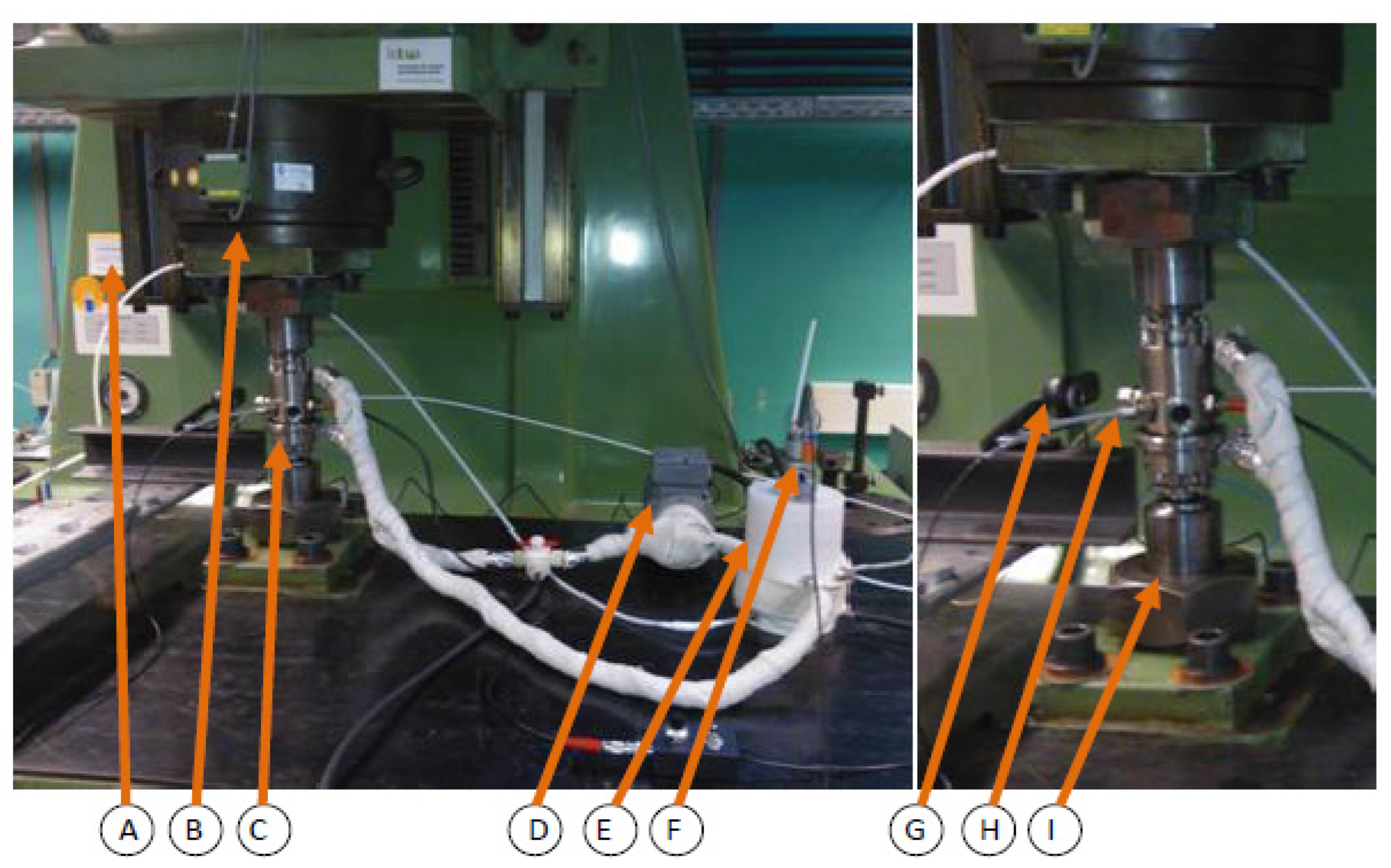
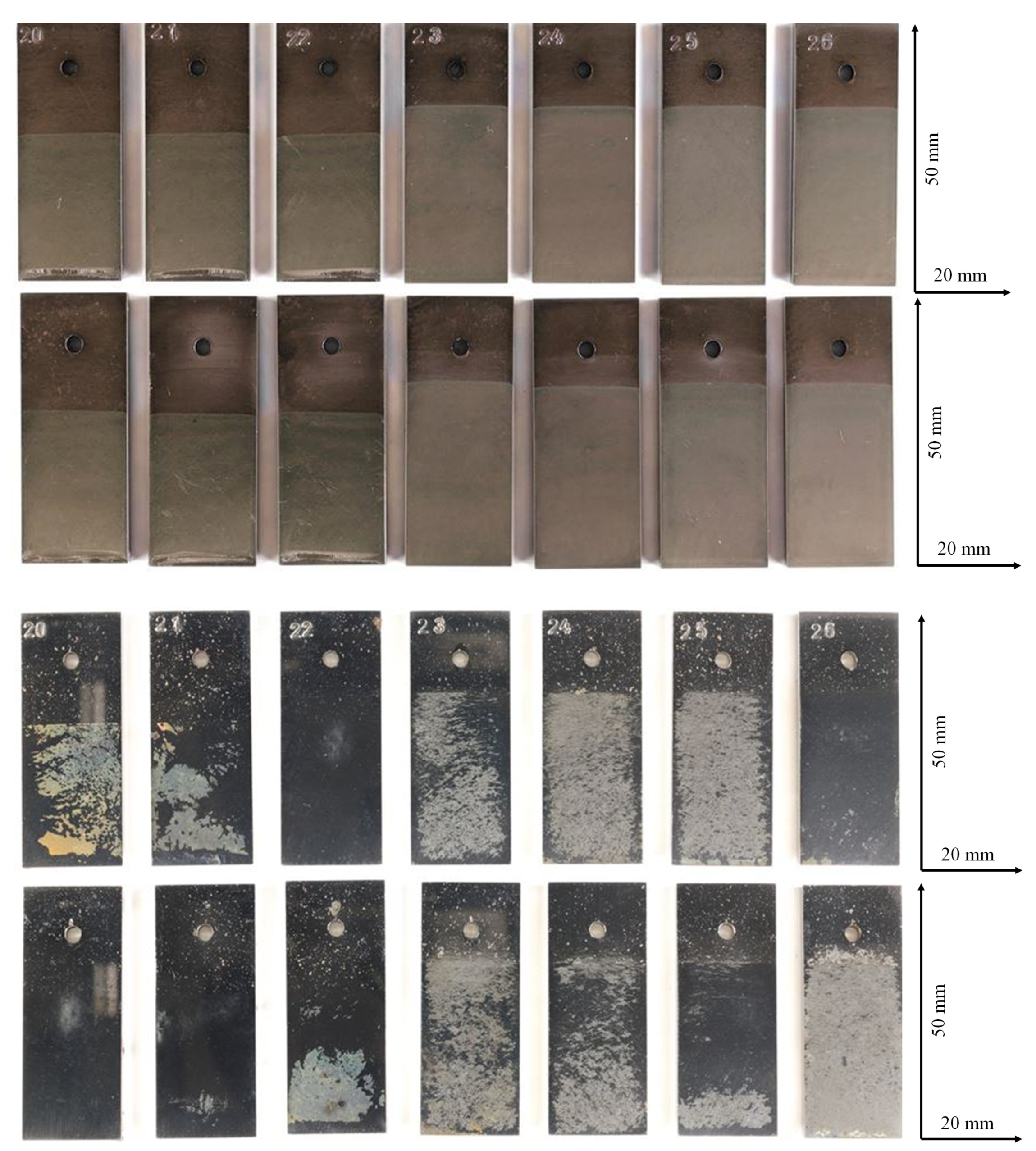
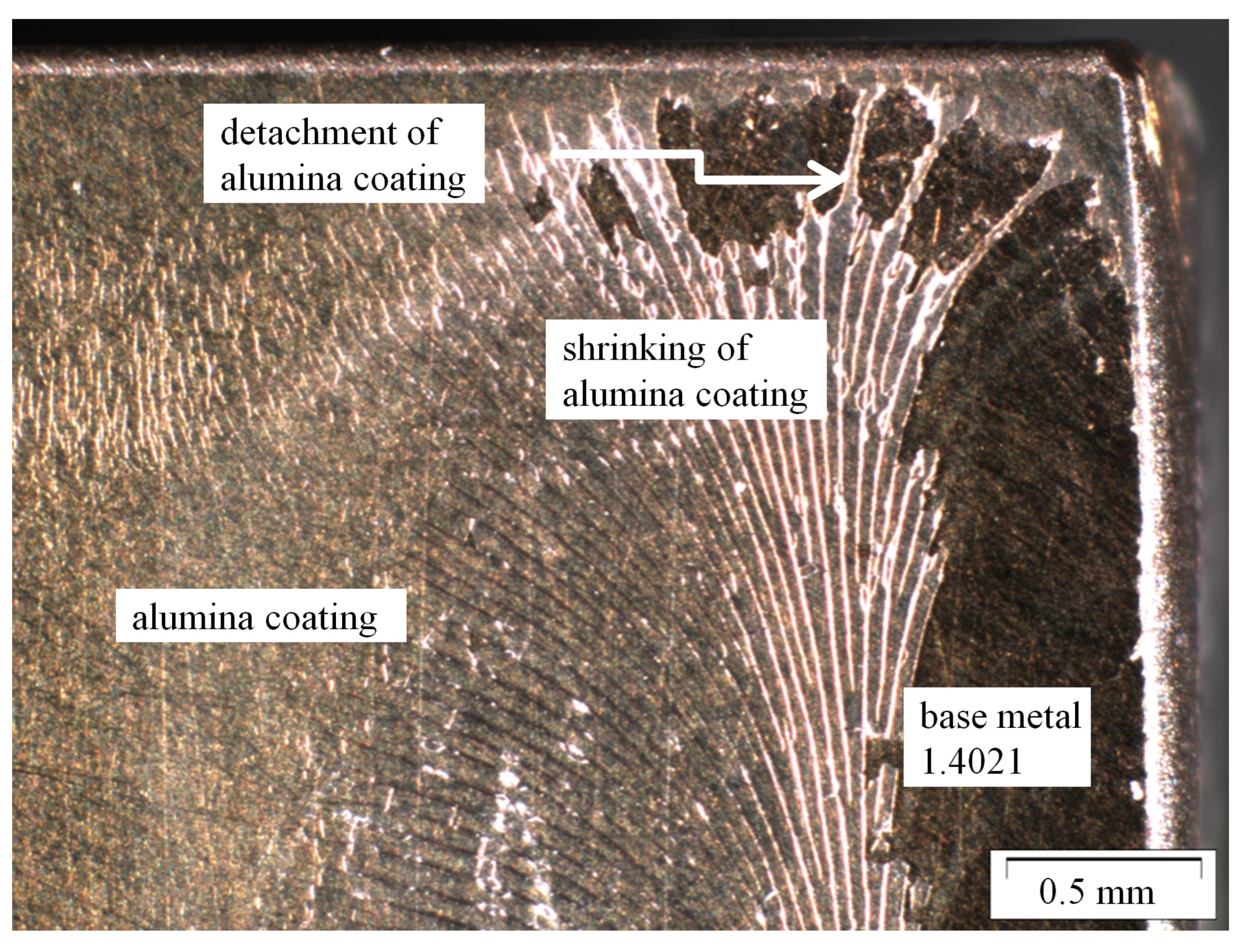
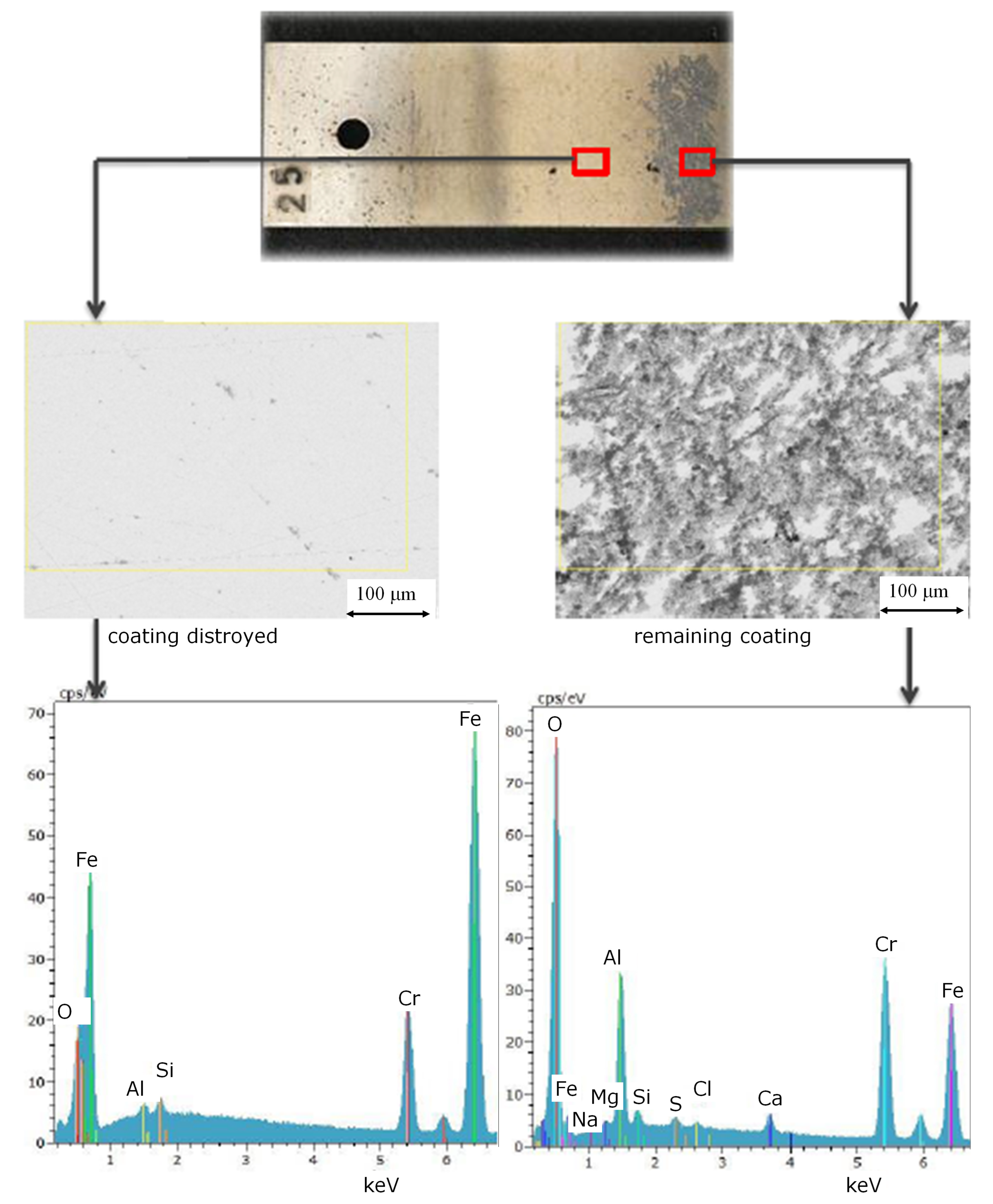
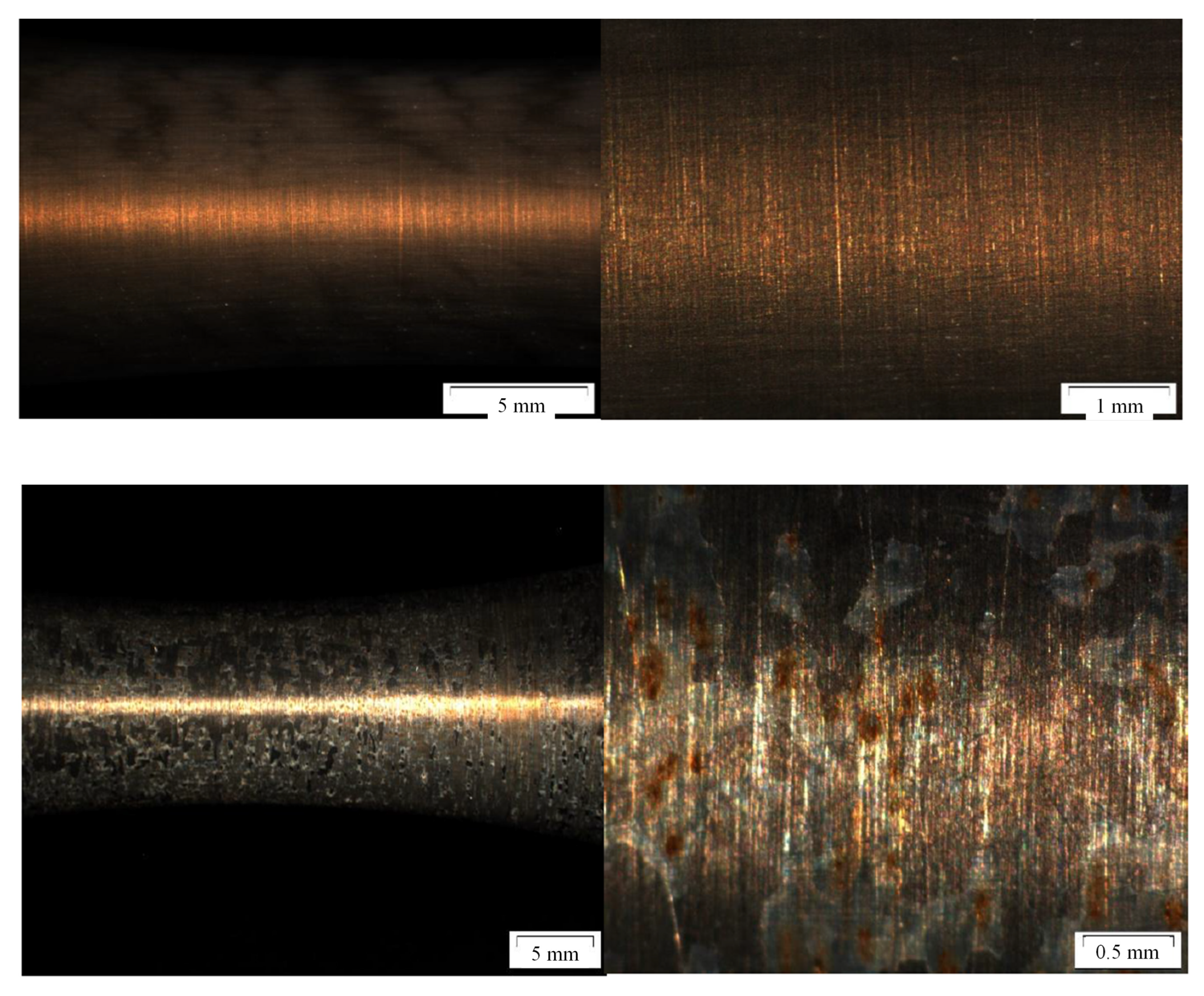
| Elements | C | Si | Mn | P | S | Cr | Mo | Ni | Cu | Nb |
|---|---|---|---|---|---|---|---|---|---|---|
| 1.4542 (X5CrNiCuNb16-4, AISI 630) | ||||||||||
| acc standard a | <0.07 | ≤0.70 | ≤1.50 | ≤0.04 | ≤0.015 | 15.0–17.0 | ≤0.60 | 3.00–5.00 | 3.00–5.00 | 0.20–0.45 |
| analysed b | 0.03 | 0.42 | 0.68 | 0.018 | 0.002 | 15.75 | 0.11 | 4.54 | 3.00 | 0.242 |
| 1.4021 (X20Cr13, AISI 420) | ||||||||||
| acc standard a | 0.17–0.25 | ≤01.00 | ≤1.00 | ≤0.045 | ≤0.03 | 12.0–14.0 | ||||
| analysed b | 0.22 | 0.39 | 0.32 | 0.007 | 0.006 | 13.3 | 0.123 | |||
| Sample Nr. | Sol | Pulling Velocity | Coating Thickness | Remarks |
|---|---|---|---|---|
| 1.4542 (X5CrNiCuNb16-4, AISI 630) corrosion fatigue specimen | ||||
| 6 TOT | water based | 30 mm/s | not applicable < 0.5 µm | uneven, layered, lateral detachments at center |
| 7 TOT | water based | 15 mm/s | not applicable < 0.2 µm | uneven, layered, lateral detachments |
| 12 TOT | water based | 15 mm/s | not applicable < 0.5 µm | uneven |
| 21 TOT | water based | 30 mm/s | not applicable < 0.6 µm | uneven |
| 1.4021 (X20Cr13, AISI 420) coupons | ||||
| 20, 21, 22 | water based | 170 mm/min | ca. 1.4 µm | |
| 23, 24 | ethanol based | 40 mm/min | ca. 0.8 µm | |
| 25, 26 | ethanol based | 170 mm/min | ca. 1.9 µm | |
| According to Stuttgart Formation | ||||||||
|---|---|---|---|---|---|---|---|---|
| NaCl | KCl | CaCl2 × 2H2O | MgCl2 × 6H2O | Na2SO4 × 10H2O | KOH | NaHCO3 | pH value | |
| g/L | 224.6 | 0.3902 | 6.452 | 10.62 | 12.074 | 0.3206 | 0.0475 | 8.2–9 |
| or | ||||||||
| Ca+ | K2+ | Mg2+ | Na2+ | Cl− | SO42− | HCO3− | pH value | |
| g/L | 1.76 | 0.43 | 1.27 | 90.1 | 14.33 | 3.6 | 0.04 | 8.2–9 |
Disclaimer/Publisher’s Note: The statements, opinions and data contained in all publications are solely those of the individual author(s) and contributor(s) and not of MDPI and/or the editor(s). MDPI and/or the editor(s) disclaim responsibility for any injury to people or property resulting from any ideas, methods, instructions or products referred to in the content. |
© 2024 by the authors. Licensee MDPI, Basel, Switzerland. This article is an open access article distributed under the terms and conditions of the Creative Commons Attribution (CC BY) license (https://creativecommons.org/licenses/by/4.0/).
Share and Cite
Pfennig, A.; Mohring, W.; Wolf, M. The Insignificant Improvement of Corrosion and Corrosion Fatigue Behavior in Geothermal Environment Applying Boehmit Coatings on High Alloyed Steels. Appl. Sci. 2024, 14, 1575. https://doi.org/10.3390/app14041575
Pfennig A, Mohring W, Wolf M. The Insignificant Improvement of Corrosion and Corrosion Fatigue Behavior in Geothermal Environment Applying Boehmit Coatings on High Alloyed Steels. Applied Sciences. 2024; 14(4):1575. https://doi.org/10.3390/app14041575
Chicago/Turabian StylePfennig, Anja, Wencke Mohring, and Marcus Wolf. 2024. "The Insignificant Improvement of Corrosion and Corrosion Fatigue Behavior in Geothermal Environment Applying Boehmit Coatings on High Alloyed Steels" Applied Sciences 14, no. 4: 1575. https://doi.org/10.3390/app14041575
APA StylePfennig, A., Mohring, W., & Wolf, M. (2024). The Insignificant Improvement of Corrosion and Corrosion Fatigue Behavior in Geothermal Environment Applying Boehmit Coatings on High Alloyed Steels. Applied Sciences, 14(4), 1575. https://doi.org/10.3390/app14041575






